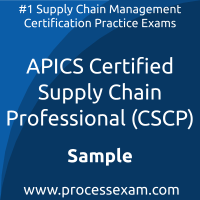 You have to pass the CSCP exam to receive the certification from ASCM. To increase the effectiveness of your study and make you familiar with the actual exam pattern, we have prepared this ASCM APICS Certified Supply Chain Professional sample questions. Our Sample ASCM APICS Certified Supply Chain Professional Practice Exam will give you more insight about both the type and the difficulty level of the questions on the ASCM APICS CSCP exam.
You have to pass the CSCP exam to receive the certification from ASCM. To increase the effectiveness of your study and make you familiar with the actual exam pattern, we have prepared this ASCM APICS Certified Supply Chain Professional sample questions. Our Sample ASCM APICS Certified Supply Chain Professional Practice Exam will give you more insight about both the type and the difficulty level of the questions on the ASCM APICS CSCP exam.
However, we are strongly recommending practice with our Premium APICS Certified Supply Chain Professional (CSCP) Practice Exam to achieve the best score in your actual ASCM CSCP Exam. The premium practice exam questions are more comprehensive, exam oriented, scenario-based and exact match of ASCM APICS Certified Supply Chain Professional exam questions.
ASCM APICS Certified Supply Chain Professional Sample Questions:
01. Which of the following approaches typically would be most effective in increasing inventory velocity in a supply chain?
a) Ensuring less idle time for inventory
b) Adding capacity at bottlenecks
c) Using faster modes of transportation
d) Using third-party logistics firms
02. The most appropriate frequency for the sales and operations planning process typically is:
a) Weekly.
b) Monthly.
c) Quarterly.
d) Annually.
03. A new manufacturing process produces waste water with higher levels of acidity than can be discharged. What can the organization do to solve this issue in a way that is also high on the waste hierarchy?
a) Lobby to get the allowed acidity levels increased.
b) Buy a base material on a waste exchange and combine the two to reduce acidity.
c) Use a waste exchange to advertise acidic water as a possible raw material.
d) Burn off the water as steam.
04. Effective data acquisition for supply chain management requires:
a) Establishment of market standards for forecasting accuracy.
b) Establishment of a six-segment matrix classifying function and innovation.
c) Identification of products that have market predictability.
d) Identification of the proper supply chain profile for the product type.
05. Which of the following measures would be most appropriate for trading partners to use to assess the delivery performance of the manufacturer of items built to forecast?
a) Percentage of items shipped within the final assembly lead time.
b) Revenue from orders shipped in a week.
c) Percentage of orders shipped complete within 24 hours of their receipt.
d) Number of items shipped within 24 hours of their receipt.
06. In a distribution network with decentralized ordering, where in the chain do you find the most variance in order quantity?
a) Customer end of the chain
b) Constant along the chain
c) Middle of the chain, diminishing toward either end
d) Raw materials end of the chain
07. Overall supply chain risk may be increased by implementing which of the following strategies?
a) Single sourcing a product that makes the highest annual profit
b) Outsourcing products that are not well suited to a company’s operations
c) Identifying multiple sources for a product with the potential for supply chain disruption
d) Internally manufacturing products with high levels of technical intellectual property
08. A manufacturing company with limited competence in logistics plans to expand into an international market. The most appropriate initial action the company should take to serve the international market is to
a) Engage a third-party logistics company.
b) Gain logistics experience.
c) Build a distribution network.
d) Buy a distribution company
09. What is the primary role of marketing in supporting supply chain management?
a) Selecting favored supplier partners
b) Developing efficient customer channels
c) Focusing on short-term forecasting accuracy
d) Working with research and development on slow-moving products
10. When determining lot sizes, consideration should be given to balancing which of the following costs?
a) Quality costs and product costs
b) Cost of goods sold (COGS) and indirect labor costs
c) Unit sales price and unit cost
d) Ordering costs and carrying costs
Answers:
Question: 01
Answer: a |
Question: 02
Answer: b |
Question: 03
Answer: c |
Question: 04
Answer: d |
Question: 05
Answer: c |
Question: 06
Answer: d |
Question: 07
Answer: a |
Question: 08
Answer: a |
Question: 09
Answer: b |
Question: 10
Answer: d |
If you find any errors or typos in APICS Certified Supply Chain Professional (CSCP) sample question-answers or online ASCM APICS CSCP practice exam, please report them to us on feedback@processexam.com
 You have to pass the CSCP exam to receive the certification from ASCM. To increase the effectiveness of your study and make you familiar with the actual exam pattern, we have prepared this ASCM APICS Certified Supply Chain Professional sample questions. Our Sample ASCM APICS Certified Supply Chain Professional Practice Exam will give you more insight about both the type and the difficulty level of the questions on the ASCM APICS CSCP exam.
You have to pass the CSCP exam to receive the certification from ASCM. To increase the effectiveness of your study and make you familiar with the actual exam pattern, we have prepared this ASCM APICS Certified Supply Chain Professional sample questions. Our Sample ASCM APICS Certified Supply Chain Professional Practice Exam will give you more insight about both the type and the difficulty level of the questions on the ASCM APICS CSCP exam.